Potato Jane
- 1½ lbs. Potatoes.
- 3 oz. Grated cheese.
- 2 oz. Breadcrumbs.
- ½ Chopped leek.
- 1 Sliced carrot.
- ½ – ¾ Pint milk or water.
- Salt and pepper.
Method, Put a layer of sliced potatoes in a fireproof dish. Sprinkle with some of the leek, carrot, crumbs, cheese and seasoning. Fill the dish with alternate layers, finishing with a layer of mixed cheese and crumbs. Pour over the milk and bake in a moderate oven for 45 minutes or steam for 1 hour.
This recipe came from the Recipes Past and Present website which takes its recipes from the Ministry of Food leaflets issued during World War II. I chose this particular recipe because it seemed pretty tame as far as not using any ingredients I didn’t like or was not willing to try, but still being a dish unlike anything I’ve ever made previously. What intrigued me was the added complexity of this dish due to the layering of ingredients which is rarely even seen today.
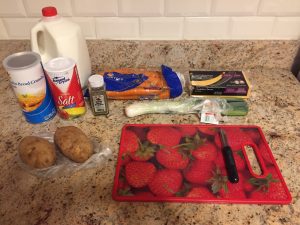
Starting work surface
This was the work surface I began my dish with. As I see it now, I’m reminded of that fact that I purchased all of these ingredients effortlessly just to make the dish and wasn’t necessarily worried about how much they would cost me or how long they would last since I, myself, am not restricted by rationing. Only a fraction of these ingredients will go into making the actual dish, and, during WWII, they didn’t have the luxury to be so easygoing with their rations.
Anyway, the recipe seems simple enough. Grate some cheese, pour some milk, and measure out some breadcrumbs. But wait, what is this thing?
Obstacle #1: The Leek
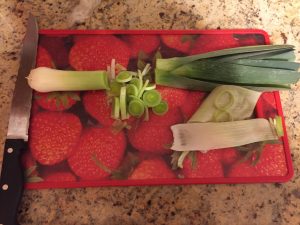
Chopping the leek
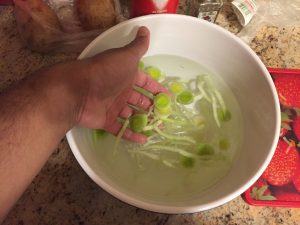
Cleaning the leek
Now, perhaps I’ve lived under a rock my whole life, but I’ve never seen nor heard of any recipes that called for a leek prior to this. I actually had to do a bit of research on what exactly it was and how I was supposed to prepare it. As seen in the pictures above, I chopped off the head of the leek, and sliced and separated the stem for cleaning. As it turns out, the leek seems to have an onion-like taste.
After I cleaned the leek for my dish I moved onto preparing the other vegetables and came across yet another dilemma.
Obstacle #2: To peel or not to peel?
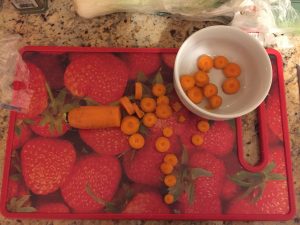
Slicing the carrot

Slicing the potato
I was conflicted on whether or not I should peel the carrot and potatoes. After doing some research, it seemed that for my purposes with this particular recipe, it would be perfectly safe to leave the skin on as long as I thoroughly cleaned the vegetables. This was more a matter of taste preferences. But I figured that if I was rationing food during WWII, I wouldn’t waste even a fraction of food if it was edible. I wouldn’t have the freedom to pick and choose based off of my own tastes due to the limited availability of food. So I ultimately chose to keep the skin on.
The final steps: assembling, layering, and baking
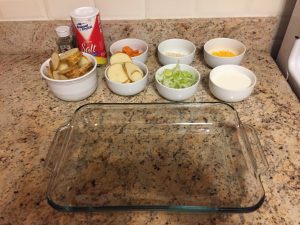
Prepared ingredients
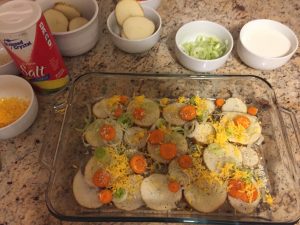
The base layer

The top layer

Ready to bake
I have a few comments here. First of all, I had no baking dishes smaller than this one and was only able to get two layers of ingredients. For anyone wanting to give this recipe a try, I would highly recommend finding a smaller dish so you can have three to four layers. Also I feel the milk was a mistake entirely. While I’ll get into it more later, even though I used the smallest measurement of milk that was stated in the recipe, the dish was still swimming in the milk and it was way too much. Surprisingly, however, the proportions of every other ingredient were very fair. While the potatoes were obviously the main focus of the dish, there was enough carrot, leek, cheese, breadcrumbs, and seasoning to go around in every portion.
Fresh out of the oven and tasting

Out of the oven
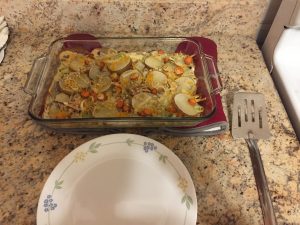
Ready to plate
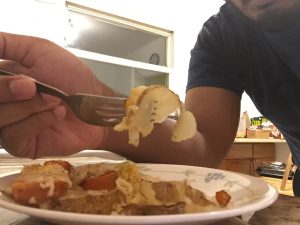
The tasting
The final verdict? By our standards it’s nothing special. Picture a baked potato but with vegetables replacing the masses of cheese, bacon, and sour cream. I can, however, see how it would be a very efficient and satisfying dish if you were rationing your food. I feel, however, I must go back to criticize the use of milk in this recipe. While the dish was baking in the oven, I noticed the milk was inflating in a strange way and resembled a fried egg more than milk. You can see in the final product where the milk just crusted over and browned on the baking dish. I’m not sure if the purpose for the milk was to keep the vegetables moist, but I would definitely keep the milk out of the recipe if I were to make it again. Overall, however, the dish was pretty average. It’s bland but it gets the job done.
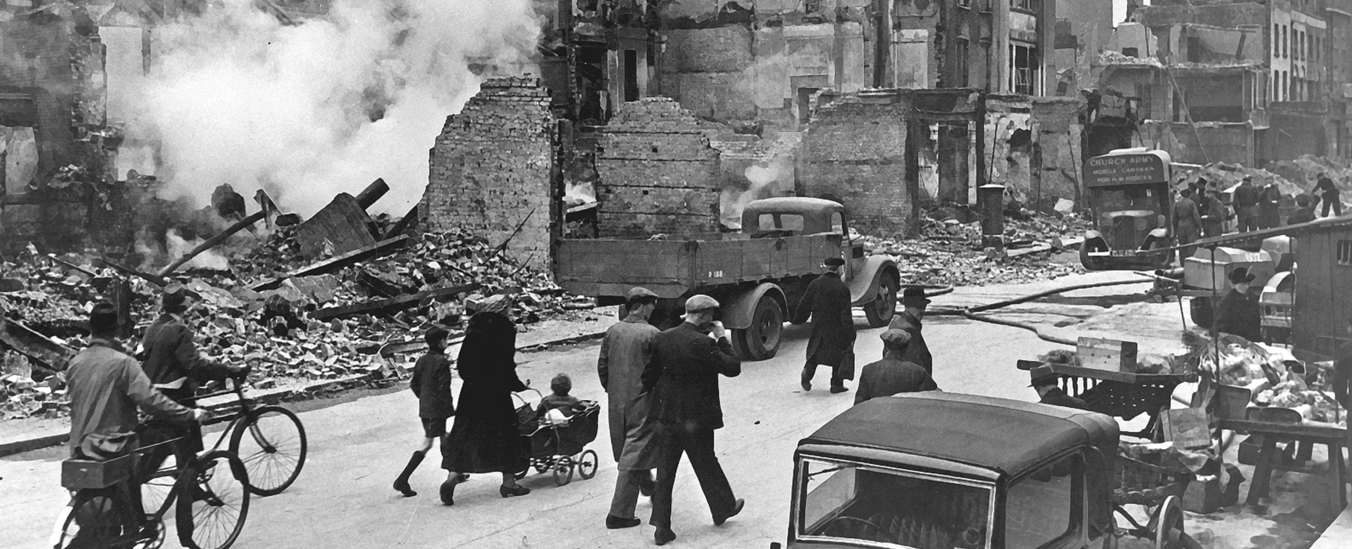






Saudia Haniff
I thought these were going to come out a lot tastier and not bland at all! Judging by the look of the finished product, it looks so colorful and delicious. Since you mentioned that you would leave out the milk if you were to re-try this recipe, is there anything that you would use as a substitute for the milk? Or would you just leave it as is (no substitutes or anything else)?
Deen Ray
Hey Saudia
I don’t cook too often so I’m not exactly sure why the liquid was necessary at all in this recipe. If I had to make a guess it would be to keep the vegetables moist through the cooking process. But to answer your question the recipe also says you can use water instead of the milk. If I were to make this recipe again I would definitely do that! Watching the milk inflate like a fried egg in the oven was quite a bit nauseating to be completely honest.
Melissa Dinsman
Hi Deen,
You mention some interesting obstacles in cooking WWII food today. Leeks are not as well known as they once were, but are making a sort of comeback these days and are often used alongside potatoes. You are right to think about how easy it is for us to purchase food items in comparison to the 1940s. I was thinking a bit about the milk question, and I think it is in part to keep the vegetables from drying out. But milk was also a huge protein source, so anywhere they could use it, I imagine they would.
Fahmida Begum
The visual of your dish looks amazing. You mentioned how you liked the fact the dish had required you to layer the ingredients. The Dish looked very complex but from your steps and images reveling to be much easier and do-able. When you mentioned the milk was baking and looking more like an egg I assumed the milk was a substitute for yogurt?